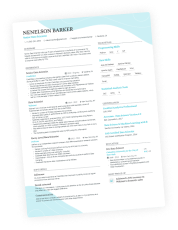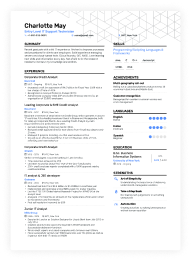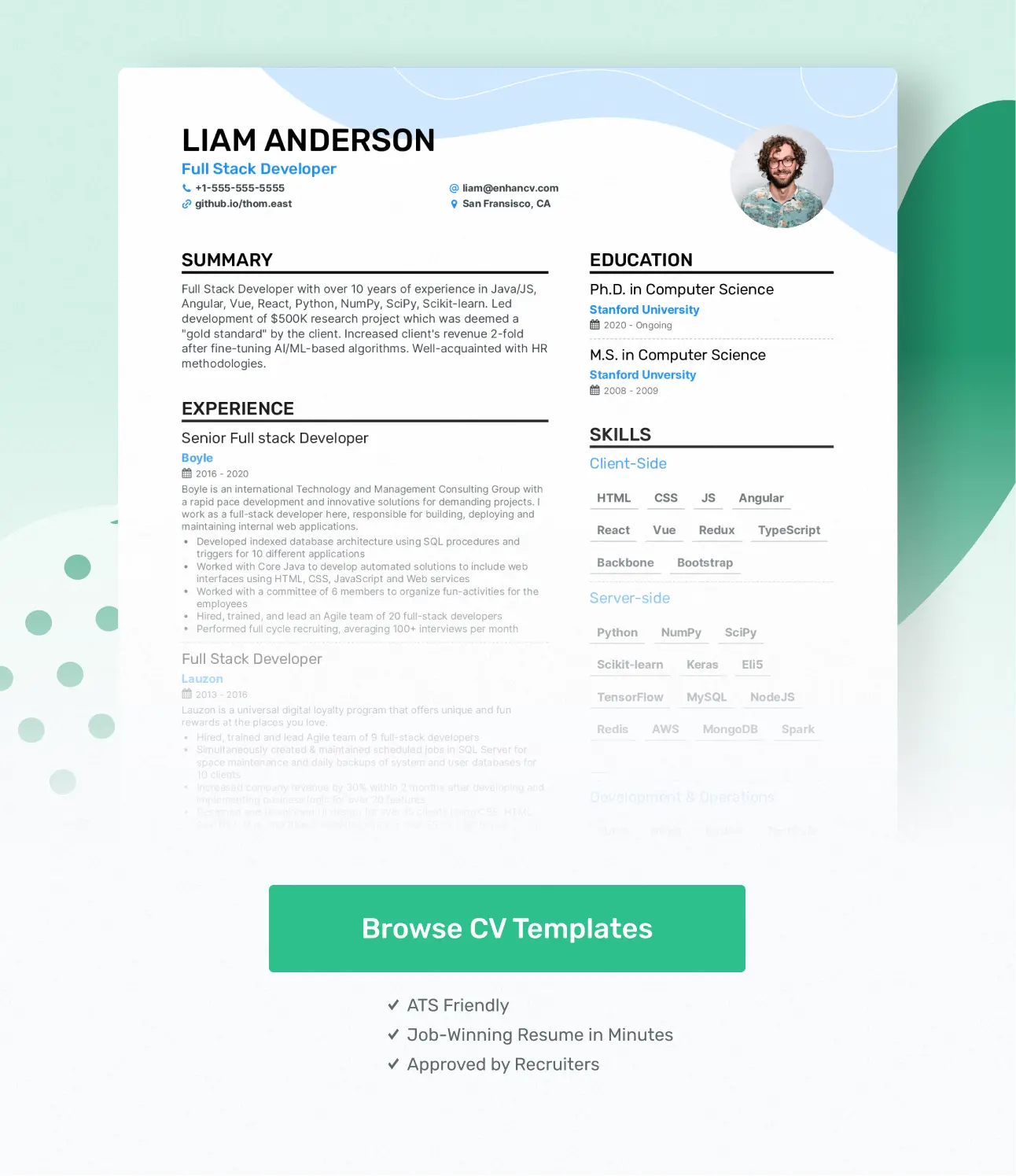You are ready to apply for a new job opportunity and advance your career, or you have just graduated and want to dive in the working world.
Either way, you might be wondering whether you should apply for a job using a resume or a Curriculum Vitae (CV). And if there even is a difference between the two.
Even though the terms are used interchangeably by employers, they actually have some key differences that you need to know about before you make your choice.
And in this article we are going to explore just that using the following questions:
- What is a CV and what to include in it?
- What is a resume and what to include in it?
- What’s the difference between a CV and a resume?
- What’s the difference between a CV and a resume around the world?
No matter which one you use, you can always spice up your application document’s design, using our Builder.
But let’s first explore what is a CV, what is a resume, and what makes them different from one another.
What is a CV and what to include in it?
Upload & Check Your CV
Drop your CV here or choose a file. PDF & DOCX only. Max 2MB file size.
The term Curriculum Vitae (CV) literally translates to “the course of your life” from Latin. And that pretty much sums up what it should consist of.
A CV is supposed to go through your whole life, your whole work history, academic accomplishments, and any publications that have your name on them.
It has no page limit. Most CVs tend to be 2-3 pages long, but if you have plenty of experience behind you, it can even exceed 10 pages.
As for the sections your CV should have, it should include:
- Your name
- Contact information
- Education
- Skills
- Experience.
But in addition to the basics, a CV should also include:
- Research and teaching experience
- Publications
- Grants and fellowships
- Professional associations and licenses
- Awards
- Other relevant information
If employers expect more candidates for a given position, they may ask for a CV summary. That is a shortened version of your CV, typically 1-2 pages long, that helps them pre-select candidates before they see your full CV.
You need to keep in mind that in the US, CVs are exclusively used for federal or academic positions. If you find that an employer is asking for a CV in a job position different than those, they might mean a resume.
And one last thing – if you are applying for a job in Europe, you should know that there the term CV is used for what is called a resume in the USA. So feel free to just rename your resume file to “[Name] CV” and you should be good to go.
<
h2 id="what-is-a-resume-and-what-to-include-in-it?">What is a resume and what to include in it?
The term resume comes from the French “résumé” which translates into “summary”. And that’s exactly a resume is – a summary of you as a professional.
It is likely that you will only need to write resumes throughout your entire life, as 99% of jobs require one, and CVs are reserved only for academic and federal jobs.
A resume should be kept as short as possible. In most cases, you should stick to a one-page resume, but if you have 15+ of relevant experience, you can extend it to a two-pager.
Either way, with that limited amount of space, you need to tailor that document to the job application and only list relevant information. It is a good practice to add a cover letter to your application that would compliment all the skills that you have mentioned in your resume.
As for the section in your resume, you should have:
- Contact Information including Job Title
- Resume Summary or Resume Objective
- Work Experience
- Education
- Skills
- Additional Sections (Awards, Courses, Resume Publications, Licenses and Certifications, Interests, etc.)
What’s the difference between a CV and a resume?
Now that you know what a CV is, and what a resume is, let’s see all the main differences between the two application documents.
There are three main differences:
- Length: The most notable difference between a CV and a resume is the page-limit. While a resume should be a one-pager (or in rare pages a two-pager), a CV has no page limit (usually 2-3 pages long, but can exceed to 10+ pages)
- Function: If you are required to write a CV, you are quite probably applying for an academic or federal position, while a resume can be used for all other jobs. Thus, you will quite probably never have to learn how to write a CV.
- Content: When you have a CV, you need just one, that is updated as you go. It should include all your academic qualifications, achievements, certifications, etc. On the other hand, a resume should be tailored to each job position you apply for, and it is a lot more focused on the relevancy of the information depending on the different job positions.
What’s the difference between a CV and a resume around the world?
Now you understand the key differences between a CV and a resume.
The thing is – these differences only apply to the USA.
Almost everywhere around the world, CV and resume are used as synonyms, and you should apply with your resume, just rename it to “[Name] CV”.
The only difference between the resume and the international CV is that the second requires more personal information than the resume.
Apart from that, you should be good to go with the document you already have good and ready.
Takeaways
We are all done, now you understand what is a CV, what is a resume, what makes them different, as well as what is the situation outside the USA.
Let’s just go through the basics one last time:
- A CV is a lengthy document that goes through all your life. It is usually 2-3 pages long, but has no page limit, so it can potentially be 10+ pages long. Some employees would first ask for a CV summary which is 1-2 pages long, before they ask for your full-size CV. Last, but not least, it is used for academic and federal positions only.
- A resume is a much shorter document – typically one page long, in rare cases a two-pager. It is much more focused on what is relevant to the position you are applying for, and should be tailored for each position you apply for. In 99% of cases, you will need to write a resume, and may never have to write a CV throughout your whole life.
- Remember that CV and resume differentiate only in the USA. The international CV format is almost the same as the US resume, with the only difference that it includes more personal information.
Now that you know the differences, and understand when to use each application file format, you can get started, and get your dream job.





